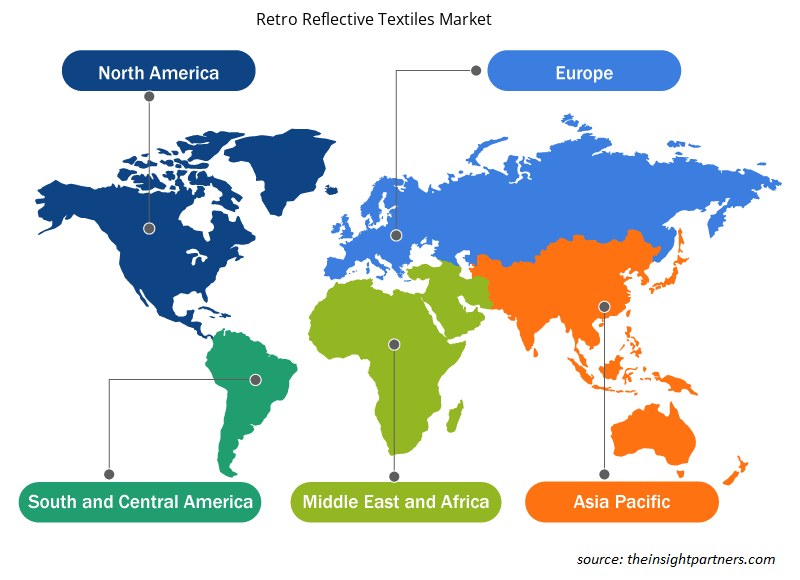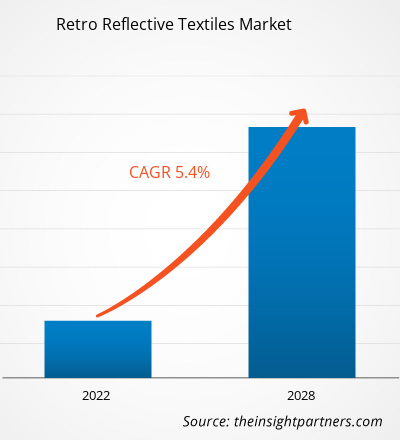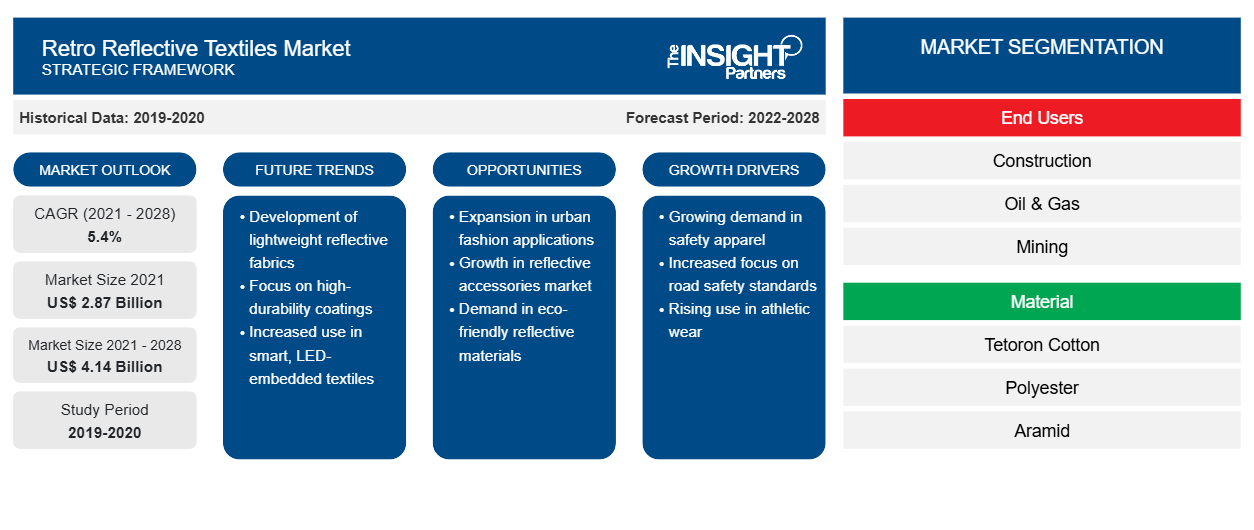[Forschungsbericht] Der Markt für retroreflektierende Textilien soll von 2.872,8 Millionen US-Dollar im Jahr 2021 auf 4.139,8 Millionen US-Dollar im Jahr 2028 wachsen; von 2021 bis 2028 wird mit einer durchschnittlichen jährlichen Wachstumsrate von 5,4 % gerechnet.
Retroreflektierendes Gewebe wird aus kleinen Glasperlen hergestellt, die Licht zurück zur Quelle reflektieren. Es wird häufig für Schutzkleidung in Branchen wie der Bau- und Transportbranche verwendet. Die Nachfrage nach retroreflektierenden Textilien ist aufgrund der Sicherheitsvorschriften verschiedener Regierungen gestiegen. Darüber hinaus hat die wachsende Zahl von Unfällen in den Endverbraucherbranchen wie der Bergbauindustrie die Nachfrage nach retroreflektierenden Textilien angekurbelt.
Im Jahr 2020 hatte der asiatisch-pazifische Raum den größten Anteil am Weltmarkt; es wird geschätzt, dass er im Prognosezeitraum die höchste durchschnittliche jährliche Wachstumsrate verzeichnet. Indien, China und Japan gehören zu den größten Marktteilnehmern. Das hohe Wachstum von Branchen wie Automobil, Transport, Bau und Infrastruktur hatte erhebliche Auswirkungen auf den Markt für retroreflektierende Textilien im asiatisch- pazifischen Raum. Die Bau- und Infrastrukturbranche wächst im asiatisch-pazifischen Raum.
Passen Sie diesen Bericht Ihren Anforderungen an
Sie erhalten kostenlos individuelle Anpassungen an jedem Bericht, einschließlich Teilen dieses Berichts oder einer Analyse auf Länderebene, eines Excel-Datenpakets sowie tolle Angebote und Rabatte für Start-ups und Universitäten.
-
Holen Sie sich die wichtigsten Markttrends aus diesem Bericht.Dieses KOSTENLOSE Beispiel umfasst eine Datenanalyse von Markttrends bis hin zu Schätzungen und Prognosen.
Auswirkungen der COVID-19-Pandemie auf den Markt für retroreflektierende Textilien
Im Jahr 2021 begannen die Volkswirtschaften, ihre Aktivitäten wieder anzukurbeln, was sich positiv auf den globalen Markt auswirkte. Die Nachfrage nach retroreflektierenden Textilien wird voraussichtlich auch für verschiedene Anwendungen, wie beispielsweise die Herstellung von Sicherheitskleidung, deutlich steigen. Darüber hinaus können die Hersteller mit voller Kapazität arbeiten, um die Lücke zwischen Angebot und Nachfrage zu schließen. Darüber hinaus sind viele Bürger verschiedener Nationen vollständig geimpft, und die Regierungen verschiedener Länder investieren in die Bau-, Infrastruktur- und Fertigungssektoren. Das Wachstum verschiedener Endverbrauchsbranchen wird voraussichtlich im Prognosezeitraum zu einer hohen Nachfrage nach retroreflektierenden Textilien führen.
Markteinblicke
Wachsende Bedeutung von Arbeitsschutzmaßnahmen und gut sichtbarer Sicherheitskleidung (HVSA)
Unfälle und Todesfälle kommen immer häufiger an Arbeitsplätzen vor, beispielsweise auf Straßen von Baustellen, in der Öl- und Gasindustrie, der chemischen Industrie und im Bergbau, wo schlechte Sicht ein Problem darstellt. In Industriegebieten werden häufig schwere Maschinen, einschließlich Kräne, eingesetzt. Arbeiter ohne Schutzausrüstung sind anfälliger für Unfälle, Verletzungen und Todesfälle, da sie von den Bedienern dieser schweren Maschinen nicht leicht erkannt werden können. Darüber hinaus sind Millionen von Arbeitern anfällig für Unfälle, Überfahren oder Rückwärtsfahren, wenn sie in der Nähe von Verkehr und Baumaschinen arbeiten. Die zunehmende Bedeutung der Sicherheit am Arbeitsplatz wird voraussichtlich das Wachstum des Marktes für retroreflektierende Textilien im Prognosezeitraum vorantreiben.
Erkenntnisse für Endbenutzer
Basierend auf dem Endverbraucher ist der globale Markt in Bauwesen, Öl und Gas, Bergbau, Transport, Feuerwehr, Strafverfolgungsbehörden und andere unterteilt. Im Jahr 2020 hatte das Bauwesen den größten Umsatzanteil; es wird erwartet, dass es im Prognosezeitraum mit der höchsten durchschnittlichen jährlichen Wachstumsrate wächst. Die Baustelle wächst mit der raschen Urbanisierung, was zu vielen thermisch bedingten Umweltproblemen führt, die durch die städtische Wärmeinsel verursacht werden. Diese Reflektoren werden in Schildern, Personalkleidung und Fahrzeugen auf Baustellen verwendet. Retroreflektierende Textilien wurden als innovative Lösung vorgeschlagen, um den für die Kühlung erforderlichen Energiebedarf zu senken und das städtische Mikroklima zu verbessern. Retroreflektierende Textilmaterialien verbessern die Sichtbarkeit und sind unverzichtbare Zubehörmaterialien. Darüber hinaus führte ein rascher Anstieg der Bau- und Infrastrukturaktivitäten zu einem Anstieg der Verwendung von Schildern und Straßenfarbmarkierungen, was das Wachstum des Marktes vorantreibt. Der Haupttreiber des Marktes für retroreflektierende Textilien sind die Großinvestitionen im Bau- und Infrastruktursektor.
3M; Daoming Optics & Chemical Co., Ltd; Hangzhou Chinastars Reflective Material Co.,Ltd; Huangshan Xingwei Reflectorized Material Co., Ltd.; PS ENTERPRISES; Swicofil AG; Unitika Sparklite Ltd.; YGM Reflective; HJ Corp; und HIGHVIZ gehören zu den Akteuren auf dem Markt für retroreflektierende Textilien. Diese Unternehmen bieten dem Markt ein breites Produktportfolio. Die Präsenz dieser Unternehmen in den Entwicklungsregionen bietet lukrative Möglichkeiten für den Markt für retroreflektierende Textilien. Die Marktteilnehmer entwickeln qualitativ hochwertige und innovative Produkte, um die Anforderungen der Kunden zu erfüllen.
Regionale Einblicke in den Markt für retroreflektierende Textilien
Die regionalen Trends und Faktoren, die den Markt für retroreflektierende Textilien während des gesamten Prognosezeitraums beeinflussen, wurden von den Analysten von Insight Partners ausführlich erläutert. In diesem Abschnitt werden auch die Marktsegmente und die Geografie für retroreflektierende Textilien in Nordamerika, Europa, im asiatisch-pazifischen Raum, im Nahen Osten und Afrika sowie in Süd- und Mittelamerika erörtert.

- Holen Sie sich die regionalen Daten für den Markt für retroreflektierende Textilien
Umfang des Marktberichts über retroreflektierende Textilien
| Berichtsattribut | Details |
|---|---|
| Marktgröße im Jahr 2021 | 2,87 Milliarden US-Dollar |
| Marktgröße bis 2028 | 4,14 Milliarden US-Dollar |
| Globale CAGR (2021 - 2028) | 5,4 % |
| Historische Daten | 2019-2020 |
| Prognosezeitraum | 2022–2028 |
| Abgedeckte Segmente |
Von Endbenutzern
|
| Abgedeckte Regionen und Länder |
NordamerikaAmerica
|
| Marktführer und wichtige Unternehmensprofile |
|
Marktdichte der retroreflektierenden Textilien: Auswirkungen auf die Geschäftsdynamik verstehen
Der Markt für retroreflektierende Textilien wächst rasant, angetrieben durch die steigende Nachfrage der Endverbraucher aufgrund von Faktoren wie sich entwickelnden Verbraucherpräferenzen, technologischen Fortschritten und einem größeren Bewusstsein für die Vorteile des Produkts. Mit steigender Nachfrage erweitern Unternehmen ihr Angebot, entwickeln Innovationen, um die Bedürfnisse der Verbraucher zu erfüllen, und nutzen neue Trends, was das Marktwachstum weiter ankurbelt.
Die Marktteilnehmerdichte bezieht sich auf die Verteilung der Firmen oder Unternehmen, die in einem bestimmten Markt oder einer bestimmten Branche tätig sind. Sie gibt an, wie viele Wettbewerber (Marktteilnehmer) in einem bestimmten Marktraum im Verhältnis zu seiner Größe oder seinem gesamten Marktwert präsent sind.
Die wichtigsten auf dem Markt für retroreflektierende Textilien tätigen Unternehmen sind:
- 3M
- Daoming Optik und Chemie Co., Ltd. Optics and Chemical Co., Ltd
- HANGZHOU CHINASTARS REFLEKTIERENDES MATERIAL CO., LTDCHINASTARS REFLECTIVE MATERIAL CO.,LTD
- Huangshan Xingwei Reflektormaterial Co., Ltd. Xingwei Reflectorized Material Co., Ltd
- PROMOSTY
Haftungsausschluss : Die oben aufgeführten Unternehmen sind nicht in einer bestimmten Reihenfolge aufgeführt.

- Überblick über die wichtigsten Akteure auf dem Markt für retroreflektierende Textilien
Bericht-Spotlights
- Fortschrittliche Branchentrends auf dem Markt helfen den Akteuren bei der Entwicklung wirksamer langfristiger Strategien
- In Industrie- und Entwicklungsländern angewandte Strategien für Unternehmenswachstum
- Quantitative Analyse des Marktes für retroreflektierende Textilien von 2019 bis 2028
- Schätzung der weltweiten Nachfrage nach retroreflektierenden Textilien
- Porters Fünf-Kräfte-Analyse veranschaulicht die Wirksamkeit der in der Branche tätigen Käufer und Lieferanten
- Aktuelle Entwicklungen zum Verständnis des wettbewerbsorientierten Marktszenarios
- Markttrends und -aussichten sowie Faktoren, die das Wachstum des Marktes für retroreflektierende Textilien vorantreiben und bremsen
- Unterstützung im Entscheidungsprozess durch Aufzeigen von Marktstrategien, die das kommerzielle Interesse untermauern und zum Marktwachstum führen
- Die Größe des Marktes an verschiedenen Knotenpunkten
- Detaillierte Übersicht und Segmentierung des Marktes sowie der Dynamik der retroreflektierenden Textilienindustrie
- Größe des Marktes für retroreflektierende Textilien in verschiedenen Regionen mit vielversprechenden Wachstumschancen
Die „Globale Marktanalyse für retroreflektierende Textilien bis 2028“ ist eine spezialisierte und eingehende Studie der Chemie- und Materialindustrie mit besonderem Schwerpunkt auf dem globalen Markt für retroreflektierende Textilien. Der Bericht soll einen Überblick über den Markt mit detaillierter Marktsegmentierung geben. Der Markt für retroreflektierende Textilien ist auf der Grundlage von Endverbrauchern, Material und Geografie segmentiert. Basierend auf den Endverbrauchern ist der Markt für retroreflektierende Textilien in Bauwesen, Öl und Gas, Bergbau, Transport, Feuerwehr, Strafverfolgungsbehörden und andere unterteilt. Basierend auf dem Material ist der Markt in Tetoron-Baumwolle, Polyester, Aramid und andere segmentiert. Nach geografischer Lage ist der Markt für retroreflektierende Textilien grob in Nordamerika, Europa, Asien-Pazifik (APAC), den Nahen Osten und Afrika (MEA) sowie Süd- und Mittelamerika unterteilt.
Firmenprofile
- 3M
- Daoming Optik & Chemie Co., Ltd.
- Hangzhou Chinastars Reflektierendes Material Co., Ltd.
- Huangshan Xingwei Reflektormaterial Co., Ltd.
- PS-UNTERNEHMEN
- Swicofil AG
- Unitika Sparklite Ltd.
- YGM Reflektierend
- HJ Corp
- HIGHVIZ
- Historische Analyse (2 Jahre), Basisjahr, Prognose (7 Jahre) mit CAGR
- PEST- und SWOT-Analyse
- Marktgröße Wert/Volumen – Global, Regional, Land
- Branchen- und Wettbewerbslandschaft
- Excel-Datensatz
Aktuelle Berichte
Erfahrungsberichte
Grund zum Kauf
- Fundierte Entscheidungsfindung
- Marktdynamik verstehen
- Wettbewerbsanalyse
- Kundeneinblicke
- Marktprognosen
- Risikominimierung
- Strategische Planung
- Investitionsbegründung
- Identifizierung neuer Märkte
- Verbesserung von Marketingstrategien
- Steigerung der Betriebseffizienz
- Anpassung an regulatorische Trends























 Kostenlose Probe anfordern für - Markt für retroreflektierende Textilien
Kostenlose Probe anfordern für - Markt für retroreflektierende Textilien